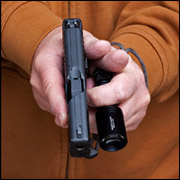As we know the UI and ergonomics of EDC lights vary tremendously, making an ideal grip on the light greatly contingent on its design.
Surefire popularized the "syringe grip" with the Rogers-Surefire technique and their series of COMBATLIGHT configurations;
While this grip and technique are well-known for use in conjunction with a pistol, I have found myself using the syringe grip for everyday use. When used with a light purposely designed to be held this way, I find the syringe grip points the light as naturally as pointing a pistol;
I also find that with a light configured to be held this way, getting a secure grip on it is fast and easy. I also find holding and using the light with this grip is very comfortable, with no need to contort the hand or wrist into a less-natural position. Always gripping the light the same way as it would be used with a pistol also has obvious advantages.
To fully leverage the syringe grip, the design of the light is critical. Obviously the grip ring is essential, to be able to squeeze the light into the thumb and activate the switch. The tailcap design is important too, as any shrouding around the switch makes activation more difficult. Finally the switch itself must not be too sensitive to prevent accidental activation yet operate with 100% reliability with a deliberate squeeze.
Fast and easy to acquire, comfortable hand positioning and intuitive pointing, consistent operation with or without a pistol - these are the reasons I have gravitated to this grip and EDC lights that are optimized for it.









 Reply With Quote
Reply With Quote




